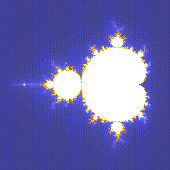Difference between revisions of "Mandelbrot"
(→Download) |
|||
| Line 107: | Line 107: | ||
== Download == | == Download == | ||
| + | |||
| + | You can download the Mandelbrot example [http://www.mesham.com/downloads/mandle.mesh here] | ||
Revision as of 17:23, 11 January 2010
Contents
Overview
The mandlebrot example will compute the Mandlebrot set over any number of processes. This is a set of points in the complex plane, the boundary of which forms a fractal. The mathematics, which are quite simple, behind the Mandlebrot computation really do not matter for our purposes. The important issue is that firstly the calculation is embrasingly parallel (i.e. simple and natural to parallelise) and secondly will produce an image which the user can identify with.
The algorithm itself is actually quite simple, with a relatively large proportion of it dealing with specific colourisation of the resulting fractal. The example on this page is purposly basic so that the potential programmer can understand it.
Source Code
var pnum:=4; // number of processes to run this on
var hxres:=1000;
var hyres:=1000;
var magnify:=1;
var itermax:=1000;
var pixel:record["r",Int,"g",Int,"b",Int];
var mydata:array[pixel,hxres,hyres] :: allocated[row[] :: horizontal[pnum] :: single[evendist[]]];
var s:array[pixel,hxres,hyres] :: allocated[single[on[0]]];
var p;
par p from 0 to pnum - 1
{
var hy;
for hy from (mydata#p).low to (mydata#p).high
{
var hx;
for hx from 1 to hxres
{
var cx:=((((hx % hxres) - 0.5) % magnify) * 3) - 0.7;
var cy:=((((hy + (mydata#p).start) % hyres) - 0.5) % magnify) * 3;
var x:Double;
x:=0;
var y:Double;
y:=0;
var iteration;
var ts:=0;
for iteration from 1 to itermax
{
var xx:=((x * x) - (y * y)) + cx;
y:= ((2 * x) * y) + cy;
x:=xx;
if (((x * x) + (y * y)) > 100)
{
ts:=iteration;
iteration:=999999;
};
};
var red:=0;
var green:=0;
var blue:=0;
if (iteration > 999998)
{
blue:=(ts * 10) + 100;
red:=(ts * 3) + 50;
green:=(ts * 3)+ 50;
if (ts > 25)
{
blue:=0;
red:=(ts * 10);
green:=(ts * 5);
};
if (blue > 255) blue:=255;
if (red > 255) red:=255;
if (green > 255) green:=255;
};
(((mydata#p)#hy)#hx).r:=red;
(((mydata#p)#hy)#hx).g:=green;
(((mydata#p)#hy)#hx).b:=blue;
};
};
};
s:=mydata;
proc 0
{
var fname:="picture.ppm";
var fil:=openfile[fname,"w"]; // open file
// generate picture file header
writetofile[fil,"P6\\n# CREATOR: LOGS Program\\n"];
writetofile[fil,1000];
writetofile[fil," "];
writetofile[fil,1000];
writetofile[fil,"\\n255\\n"];
// now write data into the file
var j;
for j from 0 to hyres - 1
{
var i;
for i from 0 to hxres - 1
{
var f:=((s#j)#i).r;
writechartofile[fil,f];
f:=((s#j)#i).g;
writechartofile[fil,f];
f:=((s#j)#i).b;
writechartofile[fil,f];
};
};
closefile[fil];
};
Notes
To change the number of processes, edit pnum. In order to change the size of the image edit hxres and hyres. The mandlebrot set will calculate up until itermax for each point, by increasing this value you will get a crisper image (but it will take much more time!) Lastly, the variable magnify will specify the magnification of the image - the value of 1 will generate the whole image and by increasing this image the computation is directed into working on a specific area in more detail.
Note: This example will produce an image in the Portable PixMap format (PPM), viewers of these on Unix based systems are easy to come by (i.e. eye of gnome) but on Windows are slightly more difficult. Windows users might want to rewrite some of the last bit on process 0 so that a BitMaP is created.
Download
You can download the Mandelbrot example here
